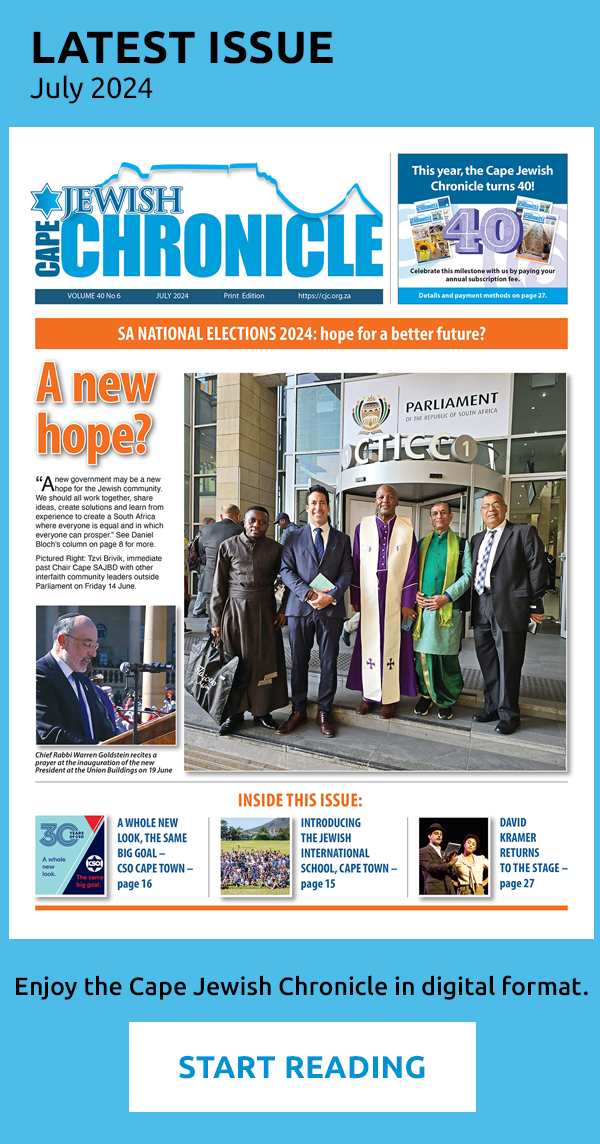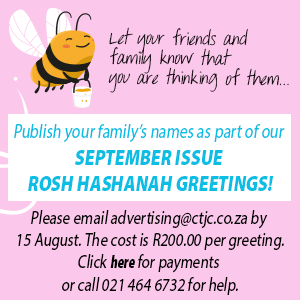By Craig Nudelman (first published 15 February 2022, by Dafkadotcom.org)
District Six is arguably one of the most challenging physical spaces confronting Cape Town, if not South Africa.
From its creation as an official ‘district’ of Cape Town in 1867, housing freed slaves, immigrants, merchants, labourers and artisans, to the largely empty and contested space it is today, this area is a potent reminder of the injustices of apartheid. Because of the forced removals of black and Coloured South Africans, which took place between 1966 and 1976, District Six has been ingrained in our minds as a symbol of apartheid and segregation. Yet, rarely featured in our national conversations is the Jewish connection to District Six. A once vibrant and multi-ethnic community, District Six was home to thousands of Jews from the 1880s to their departure in the mid-1940s and 1950s. District Six is arguably also emblematic of how Jews ‘became’ white in the South African context. Considering our long association with District Six can we also ‘claim’ District Six as ‘ours’?
Much like the Lower East Side of Manhattan and the East End of London, District Six became the area in which the newly arrived Jews, or grieners (greenhorns), settled in significant numbers. Richard Mendelsohn and Milton Shain explain in The Jews in South Africa: An illustrated history, that newly arrived Jews could “converse freely in their mame loshen (mother tongue), enjoy Yiddish theatre, read the (…) Yiddish newspaper, eat familiar foods, and pray in the (…) Eastern European mode so alien to their uptown, anglicised and more affluent co-religionists (the Anglo Jews already in the Cape)”.
Jews were first part of the working class; their relative affluence only came later. As such, they mingled comfortably amongst the District Six community, with much of their influence showing on the street. Mendelsohn and Shain quote from a newspaper, The Cape, where, in 1908, a journalist writes that “signboards are sprinkled with Yiddish characters”, “the group of men around the counters of the tailors and jewellers holding debates in Yiddish”, and “the hard white faces of the (…) haunted Russians”.
Jews established their own schools, stores, and community centres in the area. And yet they were also part of the broader neighborhood. In a Jewish Affairs article on the portrayal of Jews in District Six, Gwynne Schrire writes of how Jews would borrow eggs, milk, and sugar from their neighbours on a regular basis. District Six residents Rosa van Gelderen and Hilda Purwitzky became key educationalists at the Central Girls’ School, which was praised for its innovation and experimentation in educational practices (including sex education). This was available to all residents, regardless of religion or race. For the most part, however, Jewish residents were usually the shopkeepers, merchants, cinema-owners and landlords.
As race became the dominant organising factor in South Africa, Jews were faced with a new challenge. They came to be seen as ‘white’ and, further, were classified as such. This offered prospects they had never been afforded before, including in the countries from which they had emigrated. Milton Shain and Millie Pimstone describe this transformation in the Kaplan Centre’s and South African Jewish Museum’s 2012 exhibition, The Jews of District Six: Another Time, Another Place. As Shain and Pimstone explain, “The children of District Six rapidly relinquished their grandparents’ and parents’ insular shtetl culture and were fast becoming an integrated part of the privileged white community.” Jews began to move out of District Six to ‘whites-only’ suburbs: Highlands, Oranjezicht, Gardens, and Higgovale.
By the 1960s few Jews were resident in District Six, but remained landlords and business owners. This certainly flavoured their relations with those who were tenants and customers and affected how their respective experiences of the destruction of the District Six has been memorialised. For many former residents, remembering is also about reclaiming rights to the land and receiving compensation. This, of course, has not been an issue for former Jewish residents.
Have South African Jewry, whose wealth and position, which was aided by their racial status, mostly forgotten their humble roots in District Six?
Memorialisation of the Jewish connection to District Six is complicated. Considering that many inhabitants who were forcibly removed from District Six were Muslim, the relationship between Jews and Muslims in South Africa — both current and historical — has influenced how the Jewish connection to District Six is understood and remembered. Stemming from apartheid, race and identity have played a large part in Muslim-Jewish relations. Both Jews and Muslims are minority groups in South Africa, however, as Jocelyn Hellig points out in her article, Muslim-Jewish Relations in South Africa: A Jewish Perspective (1999), the Jewish community is one which is small and shrinking, whereas the Muslim community reflects the exact opposite. Further, Jews and Muslims had, for the most part, completely different experiences during apartheid (as reflected in District Six). Hellig states that, “they (Jews) were beneficiaries, as were all whites, of the apartheid system (and…) they have been better educated and have enjoyed higher occupational status than any other white group in the country”. Muslims, on the other hand, were generally classified as ‘non-white’, and, unlike religious Jews, were not accepted in Afrikaner Christian society. Further, the apartheid government was more accepting of Israel, whereas Islamic countries were vilified. This, Hellig suggests, “led to a great deal of defensiveness” by Jews. Not only this, but with the Group Areas Act of 1950, Jews could live in white areas, while many Muslims from District Six and elsewhere were forcibly relocated to other areas.
Another factor may be the struggle between the predominantly Zionist ideals of the Jewish community and the anti-Zionist tendency within the Muslim community. Milton Shain and Margo Bastos, in their article Muslim Antisemitism and Anti-Zionism in Postwar South Africa (2017), speak of how the relaxation of petty apartheid laws allowed for the Cape Muslim community (the majority of whom are Coloured) to become more vocal and expressive on global issues such as “Iran, Algeria and the West Bank”. This was accompanied by a concomitant rise in what many perceived as Muslim fundamentalism, reflecting global developments in the 1990s. Shain and Bastos further negate the view that Muslim-Jewish relations had always been cordial. They state, “as early as 1925, the Muslim Outlook (a Muslim publication in South Africa) had criticised ‘Jewish capitalists’ for allegedly forcing Arab peasants off the land”. This continued with the establishment of the State of Israel in 1948, where the Muslim community saw Israel and its victory as ‘barbaric’, labelling Israel “an aggressor state”. Due in part to the African National Congress’s (ANC) close ties to the Palestinian Liberation Organisation, anti-Zionism has become widespread.
Tensions over Israel have probably played a part in the Jewish community becoming marginalised in the public discourse about the history of District Six. Although there are many actors involved in how District Six is memorialised, the Muslim community, through their identity as Coloured South Africans, have been more prominent in establishing and maintaining the legacy and history of District Six. There has been some interfaith and intercommunity work which has made considerable inroads in establishing positive relations between the two communities. A vast majority of both communities, however, continue to hold suspicion and animosity towards each other, perpetuated by both internal and external factors.
District Six is a physical space which represents the destructive nature of apartheid. Its location, in the centre of Cape Town, continues to demonstrate how the ‘non-white’ population was torn apart by apartheid; its residents were pushed to the peripheries and made to settle in townships that continue to lack so many basic necessities. There are many Jews who know nothing of this heritage. This has become increasingly clear as I accompany local members of the Jewish community on tours of Jewish Cape Town. Historical connections with District Six seem to have been largely forgotten by the Jewish community, and its legacy mostly removed from our collective memory. It is incumbent on young Jewish South Africans to recall our roots in District Six in the late 19th century as poor immigrants, as well as to grapple with our complex history under apartheid. Only through such reflection and engagement can we locate our way forward in this diverse and complex country.
Published in the PDF edition of the Pesach/April 2022 issue – Click here to get it.
• To advertise in the Cape Jewish Chronicle and on this website – contact Karyn on 021 464 6700 ext. 104 or email advertising@ctjc.co.za. For more information and advertising rate card click here.
• Sign up for our newsletter and never miss another issue.
• Please support the Cape Jewish Chronicle with a voluntary Subscription for 2022. For payment info click here.
• Visit our Portal to the Jewish Community to see a list of all the Jewish organisations in Cape Town with links to their websites.
Follow the Chronicle: Facebook | Instagram | Twitter | LinkedIn










